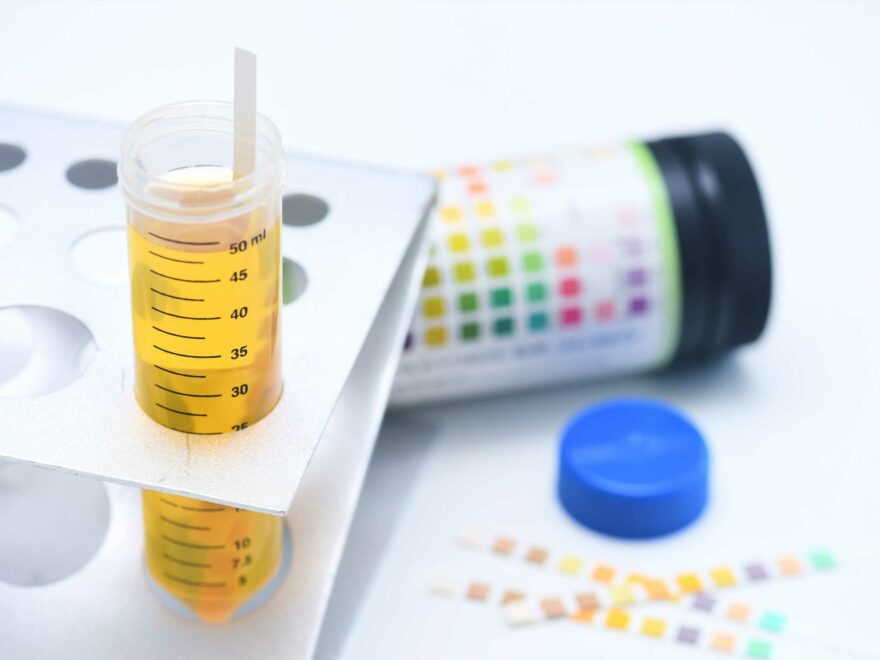CANCER could soon be self-diagnosed with a simple urine test.
Researchers have created a new nanoparticle sensor, which works much the same as a pregnancy test, to quickly and cheaply spot the killer disease.
The sensors could even be used to distinguish between different types of cancer and evaluate whether tumours are recurring after treatment.
The nanoparticles are designed to search out tumours and emit DNA sequences when they do, which are then detectable in urine.
Analysis of these DNA 'barcodes' could reveal details of a patient's tumour.
Initial tests in mice demonstrated sensors could be used to detect the activity of five different enzymes expressed in tumours, and further clinical trials in humans are in the offing.
READ MORE ON CANCER
The 5 earliest signs of skin cancer – as Chris Evans reveals diagnosis
From verrucas to cancer screenings, Dr Jeff answers your health questions
Aiming to make their test as cost-efficient and easily accessible as possible, engineers from the Massachusetts Institute of Technology (MIT) in the US designed it to be performed on a strip of paper – similar to a pregnancy or lateral flow Covid test.
Dr Sangeeta Bhatia, a biological engineer and a professor at MIT's Institute for Medical Engineering and Science and Electrical Engineering and Computer Science (EECS), said: "We are trying to innovate in a context of making technology available to low and middle-resource settings.
"Putting this diagnostic on paper is part of our goal of democratising diagnostics and creating inexpensive technologies that can give you a fast answer at the point of care."
For several years, Dr Bhatia's lab has been developing 'synthetic biomarkers' which could be used to diagnose cancer.
Most read in Health
The 5 earliest signs of skin cancer – as Chris Evans reveals diagnosis
Supermarket & NHS team up to make change to undies – it could be a lifesaver
Our boy is battling dementia aged 3 – we are making most of time he has left
The surprising foods that are making you fart – and there's not a veggie in sight
This latest project builds on previous work in detecting the biomarkers of the illness, such as proteins circulating around tumour cells in patients' blood samples.
But these naturally-occurring biomarkers are so rare – especially during the early stages of cancer – that they're nearly impossible to find.
However, synthetic biomarkers can be used to amplify these small-scale changes occurring within small tumours.
In her previous work, Dr Bhatia created nanoparticles which can detect the activity of enzymes called 'proteases' – which help cancer cells escape their original locations or settle in new ones.
These nanoparticles are coated with peptides that are split by different proteases and, once released into the bloodstream, these peptides can then be concentrated and more easily detected in a urine sample.
The original peptide biomarkers were designed to be detected based on small variations in their masses, using a mass spectrometer – but this kind of equipment is likely not to be available in lower-resource settings.
So researchers instead developed sensors which can be analysed more easily and affordably using DNA barcodes read using a specially-designed technology called 'CRISPR'.
The research team additionally had to use a chemical modification to protect the circulating DNA reporter barcodes from being broken down whilst travelling in the blood.
'FAST ANSWERS'
Each DNA barcode is attached to a nanoparticle by a linker that can be severed by a specific protease.
If that protease is present, the DNA molecule is released and free to circulate, eventually ending up in the urine.
Once the sensors are secreted in the urine, the sample can be analysed using a paper strip which recognises a reporter activated by a CRISPR enzyme.
When a particular DNA barcode is present in the sample, Cas12a amplifies the signal so that it is seen as a dark strip on a paper test.
The particles can be designed to carry many different DNA barcodes, each of which detects a different type of protease activity, which allows for 'multiplexed' sensing.
Using a larger number of sensors provides a boost in both sensitivity and specificity, allowing the test to more easily distinguish between tumour types.
In recent tests with mice, the researchers demonstrated a panel of five DNA barcodes could accurately distinguish tumours which first arose in the lungs from those formed by colorectal cancer cells that had metastasised to the lungs.
Liangliang Hao, a former MIT research scientist who is now an assistant professor of biomedical engineering at Boston University and lead author of the study, said: "Our goal here is to build up disease signatures and to see whether we can use these barcoded panels not only to read out a disease but also to classify a disease or distinguish different cancer types."
For future human use, the researchers expect that they may need to use more than five barcodes as they did in the mice, due to the variety in patients' tumours.
Towards this end, the researchers teamed up with scientists at the Broad Institute of MIT and Harvard to create a microfluidic chip which can be used to read up to 46 different barcodes from just one sample.
Read More on The Sun
Radio legend Chris Evans, 57, reveals he’s been diagnosed with cancer
Boy, 11, dies after ‘incident’ at skate park leaving locals devastated
This kind of testing could be used not only for detecting cancer but also for measuring how well a patient's tumour responds to treatment and whether it has recurred after treatment.
The researchers are now working on further developing the particles with the goal of testing them in humans.
Source: Read Full Article








